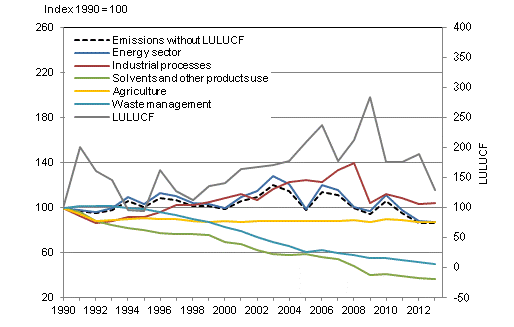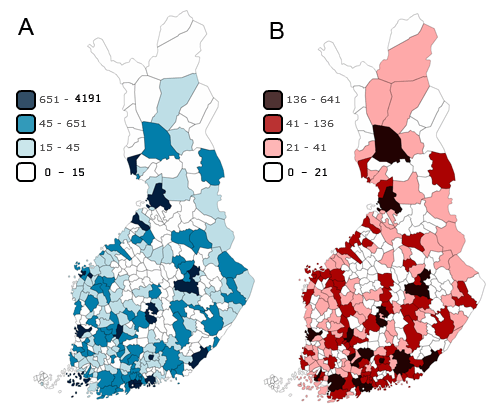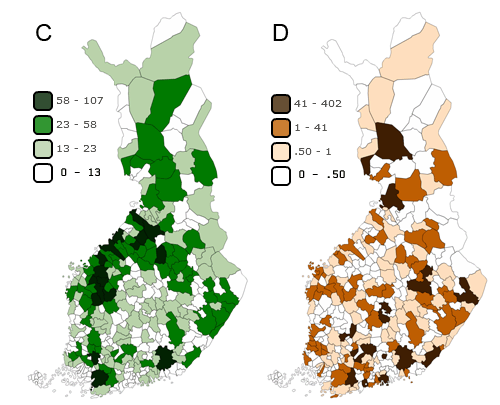Published: 22 May 2014
Finland's greenhouse gas emissions have remained low
According to Statistics Finland’s proxy estimate, the total emissions of greenhouse gases in 2013 corresponded with 60.6 million tonnes of carbon dioxide. The emissions remained almost unchanged from the year before. In the energy sector, the use of hard coal increased but the consumption of peat, oil and natural gas decreased. In 2013, emissions outside the emissions trading scheme were around six per cent below the target set by the EU. The net sink of the Land Use, Land-Use Change and Forestry (LULUCF) sector has decreased by one-third as a result of increased fellings.
Development of greenhouse gas emissions by sector in Finland in 1990–2013. The data concerning 2013 are preliminary

Statistics Finland releases proxy estimate on greenhouse gas emissions in 2013 by sector and broken down between emissions trading scheme sources and non-emissions trading scheme sources. In addition, Statistics Finland has estimated regional non-emissions trading scheme emission data by municipality and region and emissions trading scheme emission data by region for 2010 to 2012 based on where they were generated. More information on greenhouse gas emissions, their development and factors affecting the development, as well as the fulfilment of international obligations can be found in Statistics Finland's report Finland's greenhouse gas emissions in 1990 to 2012 (only in Finnish).
Finland's greenhouse gas emissions by sector (million tonnes of CO2 eq.). Negative figures indicate removal of greenhouse gases from the atmosphere
| 1990 | 1995 | 2000 | 2005 | 2008 | 2009 | 2010 | 2011 | 2012 | 2013 1) | |||
| Emissions excl. LULUCF sector | 70.3 | 70.8 | 69.2 | 68.6 | 70.1 | 66.0 | 74.4 | 66.9 | 61.0 | 60.6 | ||
| Energy sector | 54.5 | 56.0 | 54.4 | 54.0 | 54.7 | 52.7 | 60.5 | 53.3 | 47.8 | 47.5 | ||
| Domestic transport | 12.8 | 12.0 | 12.8 | 13.7 | 13.6 | 12.9 | 13.4 | 13.2 | 12.7 | 12.8 | ||
| Other than transport | 41.7 | 44.1 | 41.6 | 40.3 | 41.2 | 39.8 | 47.1 | 40.1 | 35.1 | 34.7 | ||
| Industrial processes | 5.1 | 4.7 | 5.6 | 6.4 | 7.2 | 5.4 | 5.8 | 5.6 | 5.3 | 5.4 | ||
| Industrial processes (excl. F-gases) | 5.0 | 4.6 | 5.0 | 5.4 | 6.1 | 4.4 | 4.6 | 4.5 | 4.3 | 4.3 | ||
| Consumption of F-gases 2) | 0.1 | 0.1 | 0.6 | 0.9 | 1.1 | 0.9 | 1.2 | 1.1 | 1.0 | 1.0 | ||
| Solvents and other products use | 0.2 | 0.1 | 0.1 | 0.1 | 0.1 | 0.1 | 0.1 | 0.1 | 0.1 | 0.1 | ||
| Agriculture | 6.5 | 6.0 | 5.8 | 5.7 | 5.8 | 5.7 | 5.9 | 5.8 | 5.7 | 5.7 | ||
| Waste management | 4.0 | 3.9 | 3.3 | 2.4 | 2.3 | 2.2 | 2.2 | 2.1 | 2.1 | 2.0 | ||
| LLULUCF sector 3) | -13.7 | -12.8 | -19.2 | -28.6 | -29.0 | -38.8 | -24.1 | -24.1 | -25.9 | -17.6 | ||
2) F-gases refer to fluorinated greenhouse gases (HFC, PFC compounds and SF6)
3) LULUCF refers to the land use, land use change and forestry sector
Monitoring of mandatory emission reduction targets set by the EU
The monitoring of the effort sharing decision of the EU's climate change package requires emissions data to be broken down to non-emissions trading scheme emissions and emissions trading scheme emissions. Annual emission limitations or reductions have been set for non-emissions trading scheme emissions and emissions trading scheme emissions. The Energy Authority reports the emissions trading scheme emissions to the EU Commission that monitors the fulfilment of the reduction targets. Non-emissions trading scheme emissions are calculated as the difference between the total emissions of the inventory and the emissions trading scheme emissions. In addition, the carbon dioxide emissions from domestic civil aviation are deducted from the non-emissions trading scheme emissions in the monitoring of the effort sharing decision.
Emissions trading scheme emissions grew by close on seven per cent in 2013 compared to the previous year partially due to emissions trading being expanded into new activities. In sectors outside the emissions trading scheme (e.g. use of fuel in heating of buildings, transport excl. civil aviation, agriculture, waste management and consumption of F-gases) emissions in turn decreased by good seven per cent.
Greenhouse gas emissions and removals broken down between emissions trading scheme sources and non-emissions trading scheme sources in 2005 and 2008 to 2013 (million tonnes CO2 eq.). Negative figures indicate removal of greenhouse gases from the atmosphere
| 2005 | 2008 | 2009 | 2010 | 2011 | 2012 | 2013 4) | Change, 2012–2013 |
||
| Total excl. LULUCF sector | 68.6 | 70.1 | 66.0 | 74.4 | 66.9 | 61.0 | 60.6 | -0.3 | |
| Emissions trading scheme emissions 1) | 33.1 | 36.2 | 34.4 | 41.3 | 35.1 | 29.5 | 31.5 | 2.0 | |
| Non-emissions trading scheme emissions 2) | 35.5 | 34.0 | 31.6 | 33.1 | 31.8 | 31.5 | 29.1 | -2.3 | |
| Non-emissions trading scheme emissions excluding CO2 emission from domestic civil aviation | 35.2 | 33.7 | 31.4 | 32.9 | 31.5 | 31.3 | 28.9 | -2.3 | |
| LULUCF sector 3) | -28.6 | -29.0 | -38.8 | -24.1 | -24.1 | -25.9 | -17.6 | 8.3 | |
2) Also includes the emissions of domestic civil aviation, although the emissions in question are in the emissions trading scheme of the EU's internal civil aviation
3) The land use, land-use change and forestry (LULUCF) sector does not come under the scope of the emissions trading scheme or the reduction targets of effort sharing
4) Proxy estimate
In the effort sharing decision, the target for Finland non-emissions trading scheme emissions is a reduction obligation of 16 per cent between the emissions in 2005 and the emissions in 2020. Between 2013 and 2020, the emissions must be on the so-called target path or below it. The path is linear and its starting point is the average of emissions from non-emissions trading scheme sources in 2008 to 2010 and its final point is the target for emissions reduction by 2020. Because emissions outside the non-emissions trading scheme emissions are calculated as the difference between reviewed total emissions and emissions trading scheme emissions, the effects from emissions that are moved into the emissions trading scheme in 2013 have also been taken into consideration when determining the path. Finland's emissions volume for 2013 according to the target path is thus around 31.0 million tonnes of carbon dioxide equivalent (CO2 eq.). According to the proxy estimate, the actual emissions are two million tonnes of carbon dioxide equivalent (CO2 eq.) below the target level.
The calculation of proxy emissions is carried out at a less detailed level than the final inventory calculation for 2013. Reporting and method instructions for the greenhouse gas inventory and the GWP (global warming potential) coefficients used in commensurating different greenhouse gases will change in the 2015 inventory delivery. The emission data presented here have been calculated using old methods to ensure the comparability of the time series. The official emissions data for 2013 must be reported to the UNFCCC by 15 April 2015, when the entire greenhouse gas emission time series 1990 to 2013 will be updated with the new instructions and GWP coefficients.
Regional data on emissions
Statistics Finland's calculations have been performed for the years 2010 to 2012 from the so-called region-based perspective, i.e. emissions have been allocated to their areas of origin. The data have been calculated with methods consistent with the greenhouse gas inventory by allocating emissions to regions on the basis of data on activity by municipality. The data have been separately calculated for the sectors of energy, transport, industrial processes (incl. solvent and other product use), agriculture and waste. The calculations exclude the land use, land-use change and forestry sector (LULUCF). Statistics Finland publishes only numeric data by municipality on the non-emissions trading scheme sectors for confidentiality reasons. Total emission and emissions trading scheme emissions are published on the level of regions. The emissions data can be found in the database tables .
More detailed information in Finnish can be found in the Quality description and Methodological description of the statistics.
A) Greenhouse gas emissions from the energy sector and industrial processes by municipality in 2012 (1,000 t CO2 eq.), B) Greenhouse gas emissions from transport by municipality in 2012 (1,000 t CO2 eq.)

C) Greenhouse gas emissions from agriculture by municipality in 2012 (1,000 t CO2 eq.), D) Greenhouse gas emissions from the waste sector by municipality in 2012 (1,000 t CO2 eq.)

Source: Greenhouse gas inventory unit, Statistics Finland
Inquiries: Pia Forsell 09 1734 2937 (9.6.2014 => 029 551 2937), Riitta Pipatti 09 1734 3543 (9.6.2014 => 029 551 3543), kasvihuonekaasut@stat.fi
Director in charge: Leena Storgårds
Publication in pdf-format (324.2 kB)
- Tables
-
Tables in databases
Pick the data you need into tables, view the data as graphs, or download the data for your use.
- Revisions in these statistics
-
- Revisions in these statistics (22.5.2014)
Updated 22.5.2014
Official Statistics of Finland (OSF):
Greenhouse gases [e-publication].
ISSN=1797-6065. 2013. Helsinki: Statistics Finland [referred: 19.4.2025].
Access method: http://stat.fi/til/khki/2013/khki_2013_2014-05-22_tie_001_en.html

